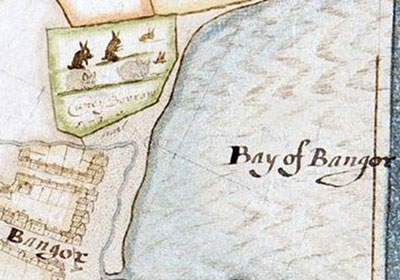 Bangor Historical Society’s final meeting of the 2012-13 season was held in North Down Museum on 11 April 2013. The meeting opened with the AGM. Current officers were re-elected. The only changes were the appointment of a new treasurer Adrianne Brown in place of Barbara Minnis and the addition to the committee of Geoff Reeves. Barbara was congratulated on her wise stewardship of the society’s funds.
Bangor Historical Society’s final meeting of the 2012-13 season was held in North Down Museum on 11 April 2013. The meeting opened with the AGM. Current officers were re-elected. The only changes were the appointment of a new treasurer Adrianne Brown in place of Barbara Minnis and the addition to the committee of Geoff Reeves. Barbara was congratulated on her wise stewardship of the society’s funds.
The speaker for the evening was Sandra Millsopp whose talk on the growth of Bangor concluded the series on Bangor 400.
Miss Millsopp took as her starting point the charter of 1613 and the Raven Maps of 1625 and looked at a number of themes which she illustrated by a series of slides. She began by explaining how the Bangor lands passed to the Ward family by the marriage of Anne Catherine Hamilton to Michael Ward in 1709 and in the late nineteenth century to the Binghams by the marriage of Matilda Catherine Ward of Bangor Castle to Baron Clanmorris.
The next theme was Bangor Castle. James Hamilton’s original house had been built by 1611. It was replaced, probably in the early nineteenth century by a gothic style building, which was in turn succeeded by the present Castle by 1852.
Bangor’ original charter was granted by James I in 1613. It created a corporation of 12 burgesses headed by a provost or mayor elected annually. It was not a democratic body as the residents of Bangor had no say in the elections of the burgesses. The most important right of the corporation was to elect 2 MPs to the Irish Parliament. Compensation of £15,000 was paid when the parliament was abolished in 1800. The corporation was abolished following a report in the 1830s. Local government was restored in 1864 with the establishment of nine town commissioners. They were succeeded by the Urban District Council, then Bangor Borough Council and now the present North Down Council.
Various features from the Raven maps can still be traced. The same streets still dominate the centre of the town: Main street, High Street, Quay Street and Queen’s Parade. The harbour with its customs house was not changed till about 1757 with the creation of a pier. Bangor Abbey is still a place of worship and the most significant changes have been the growth of the Presbyterian congregations.
Bangor was only briefly an industrial centre: the two cotton mills, in lower High Street and at the sea front had lasted barely 50 years when fire destroyed them in 1856.
The most significant changes in communications came in the mid-nineteenth century with the establishment of a regular steamboat service from Belfast and the opening of the railway in 1865. Many people now came to Bangor for the day or took a house for the season. Miss Millsopp concluded by showing pictures of some of the iconic buildings of Bangor’s seaside past such as Barry’s, Caproni’s and the Tonic Cinema. Don Patterson thanked Miss Millsopp for an interesting talk. The chairman reminded members about the society’s outing on 11th May and said he hoped to see them all in September for the opening meeting of next season.
